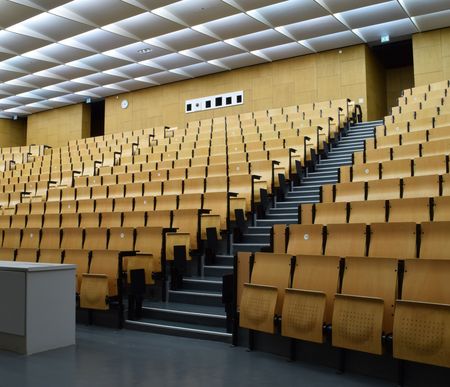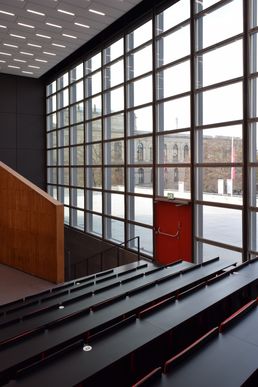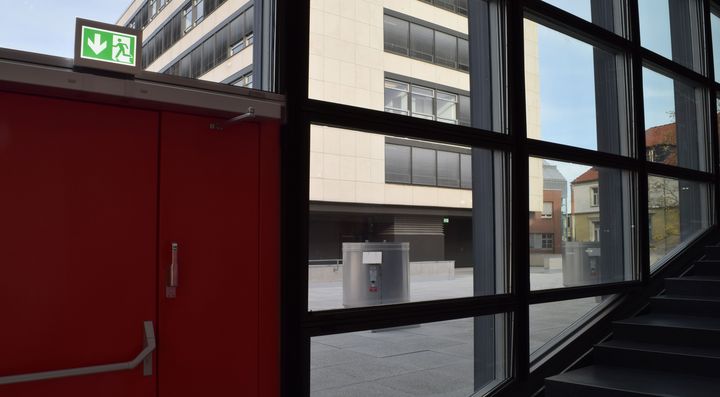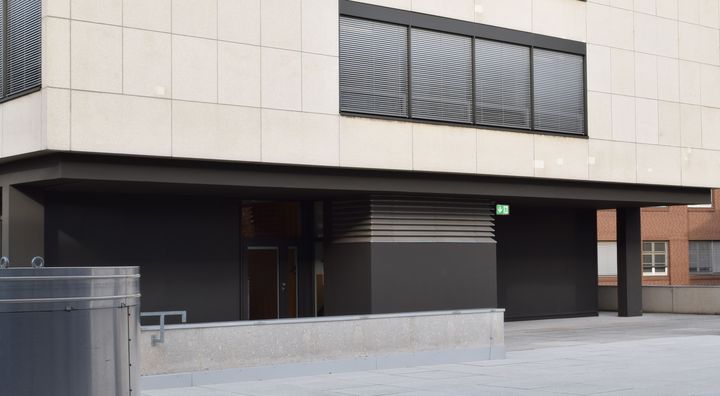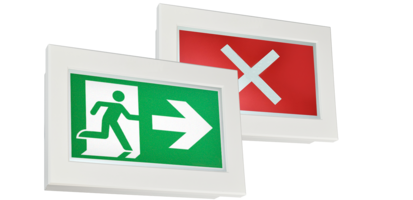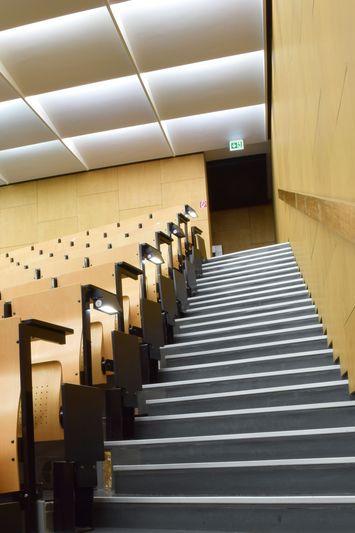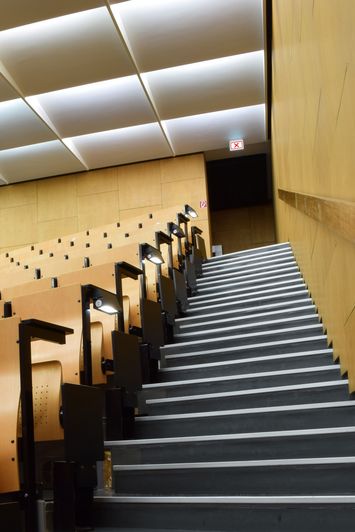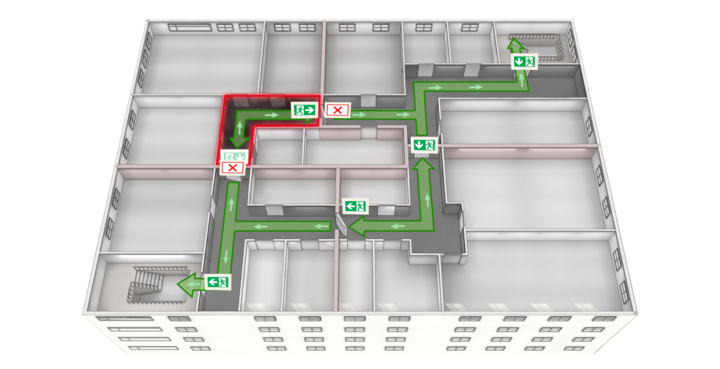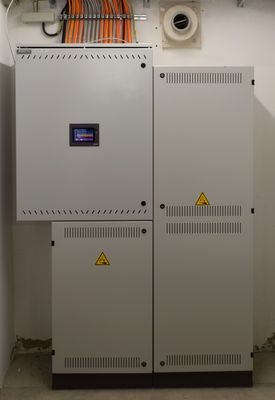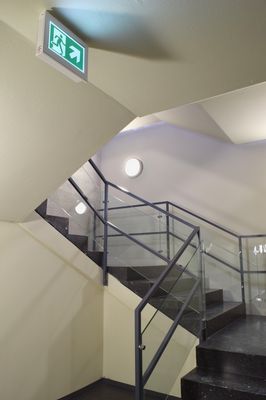Directional variable safety lighting in the Audimax Braunschweig
Fire protection renovation in a listed building
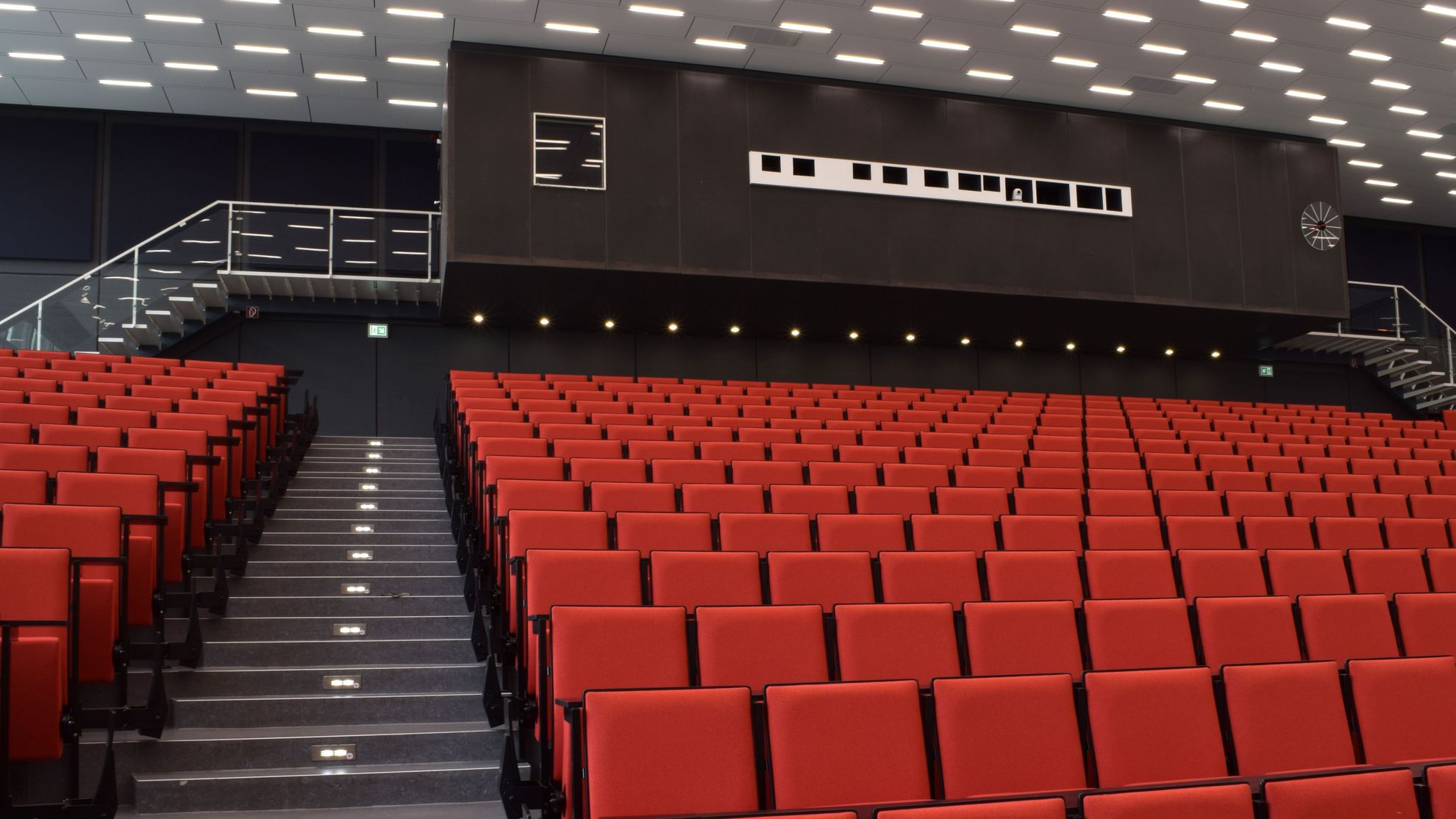
Pioneering solutions from Inotec Sicherheitstechnik are used in the Audimax at the TU Braunschweig. These solutions ensured an optimum level of fire protection while at the same time offering a high level of cost-effectiveness for the age-related refurbishment. A central safety lighting system CPS Fusion with integrated dynamic escape routing D.E.R. was installed. Thanks to innovative Inotec technologies, a substantial part of the existing cabling could be reused. Retrofits from special luminaire construction allowed the listed building to retain its appearance, thanks to modern technology.
The Auditorium Maximum (Audimax) is also a central and identity-forming location for the TU Braunschweig, fulfilling a cultural societal purpose. Built in 1961 by the architect and university lecturer, Professor Friedrich Wilhelm Kraemer. It is one of the leading buildings of university architecture after 1945. Together with the forum building and the university library, it forms the forum ensemble, which was planned by Krämer entirely in the style of the Braunschweig School of Architecture. In contrast to the disc-shaped forum building and the cylindrical library, the Audimax was designed as a cube. It houses the actual Audimax with 800 seats on the ground and upper floors and a large physics lecture hall in the two basement levels. The ground-level foyer also serves as the entrance and a lounge area. The building features large and distinctive glass façades on the north and south sides, and houses a wall installation by artist Hans Arp on the west side.
Fire protection versus preservation of historical buildings
After almost 60 years of use, the listed Audimax building no longer met current requirements in terms of functionality, sound and heat insulation and safety. Extensive building renovation had become necessary. During the planning phase, however, as with other historic buildings, the conflicting demands of protection for such buildings on the one hand, and functionality and safety on the other, became clear. During the Audimax renovation, the historic building fabric was to be preserved as completely as possible while maintaining the architectural concept and also taking into account the functionality and safety requirements of a modern lecture hall building. This task could not be solved with standard approaches, but required intelligent solutions in order to reconcile all the demands.

The challenge of escape routes
A special fire protection challenge was to secure the evacuation routes. After all, in the event of a fire in a fully occupied lecture hall, more than 1,000 people would have to be evacuated into the open and thus to safety, in the shortest possible time. The first and second escape routes in the Audimax, which are required by building law, lead via the foyer and also via the accessible roof terrace into the neighbouring buildings – thus not directly into the open air. The first escape route from the physics lecture hall leads via a hallway and a stairwell to the west, over a ramp, to the outside. The second escape route also leads evacuees via the foyer. The automatic fire extinguishing system in the foyer, required by law in this case, is not in place in the Audimax and actually cannot be installed. But what would happen if the route through the foyer was blocked by fire, for example? If no special measures were taken, there would be a risk of evacuees being led directly into the fire zone, or they would have to spend valuable evacuation time looking for an alternative escape route.
For these reasons, the decision was made to install a dynamic escape route guidance system in combination with an area-wide fire alarm system (FAS) and a voice alarm system. The alternative idea of separating the escape routes in the foyer by means of a fireproof F30 glazing with self-closing RS doors, which was mentioned in the building permit, would have incurred high costs and significantly detracted from the open character of the foyer.
Dynamic escape routing
The dynamic escape routing in the Audimax is based on directionally variable escape signs, which are coupled to the fire alarm system. As soon as a detector of a smoke or fire compartment is triggered, the affected area is visually blocked by the dynamic escape routing system and routed away from or around it. In the danger zone itself, the system indicates the shortest way out of it). Two scenarios need to be differentiated in the case of Audimax:
The foyer is accessible
Both lecture halls are evacuated via the foyer. The escape route signs indicate “free” in all areas, i.e. depending on the location, the evacuees are guided either via the foyer or via the stairwell and ramp, to the outside. At the same time, a standard voice alarm is activated, prompting people to leave the building by the shortest route.
The foyer is blocked
The escape route signs from both lecture halls in the direction of the foyer are displayed as ‘blocked’ (e.g. Red X, flashing, flashing function in accordance with DIN VDE V 0108-200 [1]). The alternative escape routes via the roof terrace or the ramp are displayed as “free” (e.g. white arrow on green background, flashing, flashing function in accordance with DIN VDE V 0108-200). A voice alarm is activated in the Audimax lecture hall, prompting people to leave via the roof terrace and indicating that the foyer is not available as an escape route. The voice alarm in the physics lecture hall indicates the escape route via the stairwell and ramp. In the foyer itself, the standard voice alarm is triggered.
In both cases, the dynamic escape route guidance system indicates the escape route to be used in the particular dangerous situation. Even if the foyer is blocked, evacuees can thus reach the outside quickly and without delay. The escape sign luminaires are positioned in accordance with DIN EN 1838 [2] at every exit door to be used in an emergency, at every change of direction and at every intersection of corridors or hallways. The FL 2820 TFT luminaire from INOTEC is used for dynamic escape route marking. Activation takes place via only a single potential-free contact of the BMA – a very simple control with great gain in safety. For safe differentiation, a two-detector dependency is implemented in the foyer, i.e. the alternative escape route guidance is only triggered when two detectors detect smoke.
The challenge of safety lighting
- The safety lighting in the Audimax had to be fundamentally modernized due to its advanced age. Since security luminaires are usually clearly visible, special solutions had to be found: on the one hand the existing appearance had to be preserved, while on the other hand, the current regulations had to be met. Several measures were implemented in the Audimax.
- The security lighting control centre was replaced. A CLS Fusion central battery system from INOTEC is now used. The special feature: It allows a directionally variable safety lighting system with dynamic escape routing in end circuits with just three wires. This meant that the existing cabling could continue to be used without restrictions, for the control and power supply of the dynamic escape sign luminaires.
- In the physics lecture hall the existing lighting was retained. Since interference with the general lighting was to be avoided, separate SN 8400 FLD emergency luminaires in square design with individual monitoring, were used.. They were mounted concealed so that the area-wide safety lighting with an illuminance of at least 1.25lx (according to DIN EN 1838 [2], including the aging reserve of the illuminants) was realized via indirect light (according to DIN EN1838, the first reflection may be taken into account). For the illumination of the stairwells, the existing chair row luminaires were kept in use and only equipped with a monitoring module in a concealed installed and colour-coordinated junction box.
- The existing luminaires in the foyer could not be replaced my modern luminaires due to historic building protections. They were therefore reconstructed using modern LED technology. About one third of the luminaires were equipped with a monitoring module for area-wide safety lighting of at least 1.25 lx [2] and included in the safety power supply.
- For the Audimax lecture hall, the existing luminaires were reconstructed in linear optics and with old 58W T8 fluorescent tubes using modern LED technology in original dimensions. About one third of the luminaires were equipped with a DALI capable monitoring module for area-wide emergency lighting of at least 1.25 lx [2]. In the event of a power failure, the DALI module takes over the lighting control of the connected luminaire and switches it to maximum luminous flux regardless of the pre-set luminance. By using the retrofits, energy consumption was reduced by around two thirds. For stairwell lighting, the existing SN 6109 stair luminaires from INOTEC were upgraded with monitoring electronics for emergency lighting. The luminaries with a protective extra-low voltage of 24V are supplied and monitored via the central battery system with 24V bus-substations. It was possible to use the two-core existing cable since a protective earth conductor is not required for a protective extra-low voltage.
Economical execution
The generally high cost of refurbishing historic buildings is incentive enough to exploit every possible cost saving, but without jeopardizing the fire protection goals. INOTEC’s innovative technologies made exactly this possible during the refurbishment of the Audimax Braunschweig. Dynamic escape routing is extremely economical to implement and eliminates the need for other complex and therefore expensive technical solutions. Thanks to the practical INOTEC solutions, it was possible to continue to use the existing cabling for the emergency lighting, including the dynamic escape signs. By rebuilding the existing luminaires in a retro look, but with modern LED light sources, up to two thirds of the operating costs for electricity, can be saved. As a result, the appearance of the Audimax has remained virtually unchanged. Even the old battery cabinets for the power supply were reused and simply fitted with new contents – even if the appearance suffers somewhat as a result.
Fazit
Fire protection refurbishments in listed buildings require intelligent and flexible solutions in order on the one hand, to preserve the building fabric and its appearance as completely as possible and, on the other hand, to ensure the economic viability of the project. Modern safety lighting systems make it possible to implement almost all possible variations. In many cases, they allow the continued use of the existing cabling for power supply and control of new emergency luminaires and escape route signs and even the cost-effective integration of dynamic escape route guidance without additional bus lines.
